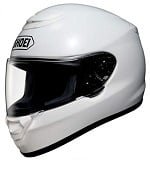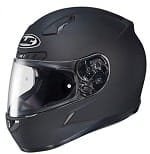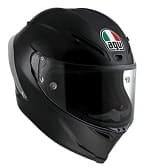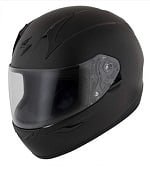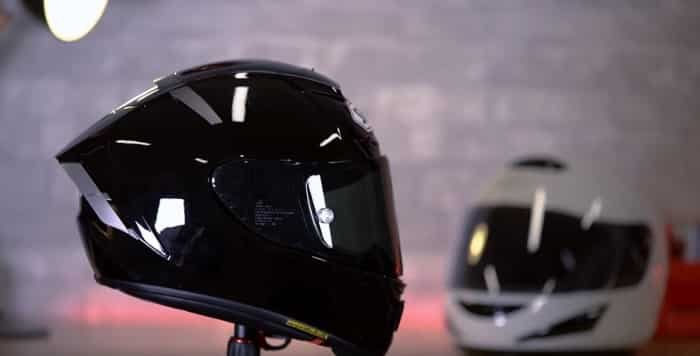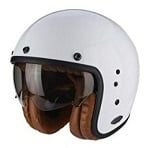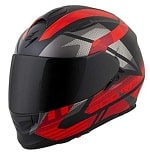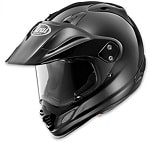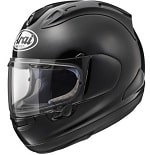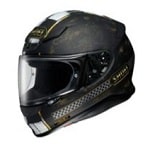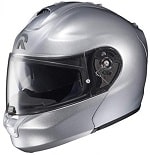There are four types of motorcycle helmets but which is the right one for you?
Types Of Full Face Helmets
- Street Bike Full Face Helmets
- Modular Full Face Helmets
- Off-Road Full Face Helmets
- Dual-Sport Full Face Helmets
Today we are going to discuss the different types of full face helmets, what you can expect from each, what riders are going to be into with each kind of motorcycle helmet and a couple of key things to look for from each category.
We’ll start with that, keep going through it and later on we’ll get to the different sections so let’s get started.
Street Bike Full Face Helmets

So right off the bat, we’re going to start with the full face. This is probably what you have in mind when you think of a motorcycle helmet, it basically refers to full coverage.
So you have full coverage on the top of your head, the back, on both sides and most importantly on the front with the chin bar. This is what really makes it a full-face helmet.
Forty-five percent of motorcycle crashes are going to involve an impact at some point on the chin bar, so if you are concerned about safety it’s important to have that for sure.
Full face helmets are going to vary a lot depending on the riding position you choose, so if you’re an ATV rider, if you’re a tour or a cruiser rider you have that upright stance, the helmets going to have to complement that.
One thing that these types of full-face helmets are going to have is a chin bar that extends a little bit lower just to get that exposure portion of your neck covered. The I port is going to extend basically neutrally straight ahead as you would be looking and you’re going to get ventilation towards the front of the helmet which is where the most airflow is going to be.
If you bent your head forward that what’s called the tuck position, this is your really really aggressive sport rider. Again, you’re going to see the opposite of what we had before so the chin bar is probably going to be a little bit higher on your face just because you’re going to be bent over like that.
The I port is going to be extended towards the top of the helmet in relative terms because you’re going to be looking ahead and you’re going to get more ventilation on the top of the head as well because that’s where most of the airflow is going to be coming in.
The other thing that’s really important about full-face helmets is the face shield. Choosing the color for this is really really important. Clear ones are going to be great for anyone who does a bit of night riding, the yellow and rose-tinted visors are great for anyone who’s in cloudy conditions or if you ride in a lot of fog, if you’re an ATV rider and you do a lot of mountain riding this is something you might be thinking about.
The dark sort of a light smoke color visor is great for someone who rides in bright conditions. The really dark mirrored or pitch-black sort of blackout visors have to be taken with caution.
They’re great for bright conditions but you have to be aware of things like tunnels because if you go into a tunnel it can get suddenly dark and you could just smack into a wall because you’ll be going in blind as you enter the tunnel.
One way to get good versatility like on the Shoei helmet is with a drop-down Sun visor. This is one way that you can get a little bit of the best of both worlds. You may also want to pay attention to UV protection, these will often have a rating that goes along with it so if you have sensitive eyes it could be something to look for.
Obviously the benefit of a full-face helmet is the protection and the downside to them is going to be the heat.
You’re locked in there so it’s going to be hard, it’s going to be stuffy especially in warm temperatures. So if you live in a hot climate be sure to look for something that’s going to have a lot of ventilation with it.
If you’re a really really sweaty guy and you tend to sweat a lot in your face then find a visor that’s going to have an anti-fog and coating on it as well, that could be really important.
Modular Full Face Helmets

The next type of motorcycle helmet we’re going to look at is a modular helmet. This helmet looks similar to the last one, it looks like we’re talking about the exact same thing and in many ways we are, but of course, it is going to be a transformer.
Some riders open the face portion fully and ride around with it open but you’re not supposed to ride in this position, this will turn your head into a windsock If you try to do it.
It looks kind of dorky if you ride with it fully open but when you’re pulled over at a traffic light or if you want to stop on the side of the road, read a map, have a smoke talk to your friends, whatever you got to do this type of helmet can be an option for that.
Modular helmets are very popular with ATV riders, sports tours and cruisers with a lot of people who sit in that upright position. It’s really common to see them designed to be ridden with the head level and looking straight forward.
It’s rarer to find a modular helmet that’s meant to be in that aggressive tuck position we discussed previously although there are a few options. The bell revolver would be a really really good one to look at if you are looking for a sporty or modular helmet.
The last thing to note with these is that they’re inherently just a little bit less safe than a full-face helmet and that’s just because the hinge mechanism just introduces a little bit of a break in what would otherwise be a totally uniform one-piece structure.
So it’s a little bit less strength in this but obviously is going to be way better than like an open-faced helmet or a half helmet or you have no lower face coverage at all.
Off-Road Full Face Helmets

The next type of full-face helmet we’re going to look at is the full-on dirt helmet which is best for that off-road environment.
The dirt bike helmet comes with a really really pronounced Sun Visor, this keeps the sun out of your eyes it’s going to prevent that mile-high roost from coming down towards your eye-port as well.
The chin bar is way out there, it’s totally angular and this is great for allowing airflow to come up inside. This full-face helmet is really geared towards two ends and that’s minimizing weight and maximizing airflow.
The whole design is really geared towards that and that’s important because off-road riding is really really physical. It’s really aggressive, you’re going to be sweating a lot, it’s used in really really hot temperatures normally and its relatively slow speeds. So it’s important to have that lightweight and it’s important to have that airflow.
You’ll notice in the eye-port that it’s meant to be used with goggles, one thing to know what this is that if you want a really perfect interface between your goggles and your helmet, it would be a great idea to buy the same manufacturer for each.
For example, if you purchased a Thor helmet they’re big-time dirt manufacturer and of course, they also make goggles.
So if you’re going to buy the Thor lid and then get the Thor goggles that the OEM suggests to go with that helmet because you’re going to get like a really flawless fit from that, that’s an important thing to note with dirt helmets.
These types of full-face helmets will often be a little bit cheaper than the other ones just because there’s less going on and they don’t have to worry about soundproofing and all that stuff.
Dual-Sport Full Face Helmets

We go towards the dirt side with the dual sport helmet. These helmets are also called crossover helmets, Enduro helmets and basically they’re meant to be ridden sort of 50% on the road 50% off, and you can really see that just by looking at them.
It looks kind of like the lovechild between a full-face helmet and an off-road or motocross helmet. You have a Sun Visor but it’s not quite as pronounced and it’s going to be aerodynamic to avoid helmet lifts at highway speeds.
In the same way, you have the angular chin bar but it’s a little bit truncated, it’s brought in a little bit and that’s going to add to the warmth. It’s going to decrease the airflow a little bit and bring better soundproofing to it.
It’s right in the middle of the range and you know you’re going to have soundproof and you’re going to have warmth but not as much as you would get from a standard on-road full-face helmet.
In the same way, you’re going to have airflow it’s going to be lightweight, but not as much as a traditional motocross helmet. One thing to note with this helmet that is particularly important is with the visor up you can use goggles beneath it as well, so that gives you great versatility.
If you’re just doing a ride where you ride to the trailhead and you’re going to be off-road all day, then it’s a great option to be able to put goggles under this and you’re going to get closer to that true motocross feel.
And if you’re doing more 50/50 riding the visor down you have a great functional helmet for that as well.
So that’s the last type of full-face helmet we will be looking at today. That’s a way to tell the difference between them all, a couple of things to look for and with that information, you should be well-armed to go out and decide what type of full-face helmet you want to look for.
